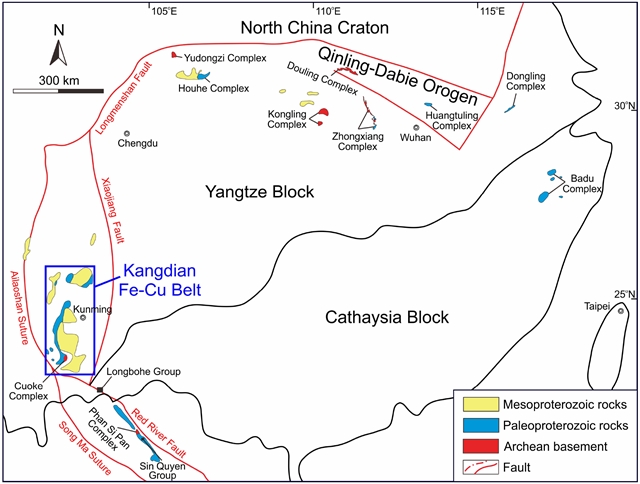
近日,中国地质大学(武汉)赵新福团队研究了扬子地块西南缘氧化铁-铜-金(IOCG)矿床及其与晚古元古代裂谷事件的关系。该研究于2025年10月23日发表在《中国科学:地球科学》杂志上。
最近在扬子地块陆续发现大量古元古代地质记录,包括23-21亿年前的岩浆岩和20-19亿年前的高级变质岩,这些记录被认为与哥伦比亚(或努纳)超大陆拼合期间的造山事件有关。在扬子地块西南缘广泛发育晚古元古代(17.5-16.8亿年)沉积-火山序列,包括东川群、河口群和大红山群。这些地层被认为形成于哥伦比亚超大陆拼合后的陆内裂谷盆地,是定位扬子地块在哥伦比亚超大陆中位置的关键证据。该套地层中发育数十个铁铜多金属矿床,传统上被解释为海相火山岩容矿的铁(铜)矿床。
然而最新研究表明,这些矿床的赋矿围岩主要为遭受强烈热液蚀变的泥质粉砂岩和碳酸盐岩,夹少量火山岩夹层。矿床主要受区域断裂控制,呈现层控型矿体并显示热液交代特征,发育典型铁氧化物-铜-金(IOCG)矿床的热液蚀变相,且与热液角砾岩及辉长辉绿岩侵入体密切共生。最新年代学和地球化学证据表明,这些IOCG矿床形成于晚古元古代(17-16.6亿年),与区域内具有板内地球化学特征的辉长岩岩墙/岩席就位时代一致。此外,这些IOCG矿床受到后期多期次岩浆事件和/或变质作用叠加改造,导致同位素年龄分布范围较广,进而引发不同成因解释。
磷灰石和褐帘石原位Nd同位素、以及电气石原位B同位素研究显示,成矿物质和早期流体主要来源于地幔相关岩浆岩,而在晚期硫化物铜矿沉淀阶段则有大量盆地卤水参与。扬子地块西南缘这些早古元古代IOCG矿床,共同构成了在陆内裂谷盆地环境中形成的IOCG成矿带。该成矿带可与澳大利亚和北美同时代IOCG矿床对比,是哥伦比亚超大陆拼合后初始裂解阶段的产物。
附:英文原文
Title: Iron Oxide-Copper-Gold (IOCG) deposits in the southwestern margin of the Yangtze Block and their relationship with the late Paleoproterozoic rift event
Author: Xinfu ZHAO, Zhikun SU, Xueqing YIN, Jianwei LI, Meifu ZHOU
Issue&Volume: 2025/10/23
Abstract: Numerous Paleoproterozoic geological records, including 2.3–2.1Ga magmatic rocks and 2.0–1.9Ga high-grade metamorphic rocks, have been recently reported in the Yangtze Block and have been considered to record the orogenic event during the assembly of the Columbia (or Nuna) supercontinent. Late Paleoproterozoic (1.75–1.68Ga) sedimentary-volcanic sequences, including the Dongchuan, Hekou, and Dahongshan groups, are widely developed in the southwestern margin of the Yangtze Block. They are considered to form within an intracontinental rift basin after assembly of the Columbia supercontinent and serve as key evidence for positioning the Yangtze Block in Columbia supercontinent. Dozens of iron-copper polymetallic deposits occur within these strata and are traditionally interpreted as marine volcanic-hosted iron (-copper) deposits. However, recent studies have indicated that the host rocks are predominantly intensely hydrothermally altered argillaceous siltstones and carbonates, interbedded with minor volcanic rocks. These deposits are primarily controlled by regional faults, and have stratabound orebodies exhibiting hydrothermal replacement characteristics. They display hydrothermal alteration phases typical of Iron Oxide-Copper-Gold (IOCG) deposit, and are closely associated with hydrothermal breccias as well as gabbro-diabase intrusions. The latest geochronological and geochemical evidence indicate that these IOCG deposits formed in the late Paleoproterozoic (1.7–1.66Ga), contemporaneous with the emplacement of regional gabbroic dikes/sills exhibiting within-plate geochemical signatures. In addition, these IOCG deposits have been overprinted by later multiple magmatic events and/or metamorphism, resulting in a wide range of isotopic ages and leading to different interpretations. In-situ Nd isotope studies of apatite and allanite, along with in-situ B isotope studies of tourmaline, suggest that the ore metals and early-stage fluids were predominantly derived from mantle-related magmatic rocks, while significant involvement of basinal brines occurred during the late-stage Cu-sulfide precipitation process. These early Paleoproterozoic IOCG deposits in the southwestern margin of the Yangtze Block represent an IOCG metallogenic belt formed in an intracontinental rift basin. This belt is comparable to contemporaneous IOCG deposits in Australia and North America, and represents the products of the initial extensional breakup after the assembly of the Columbia supercontinent.
DOI: 10.1007/s11430-025-1730-9
Source: https://www.sciengine.com/SCES/doi/10.1007/s11430-025-1730-9
Science China Earth Sciences:《中国科学:地球科学》,创刊于1952年。隶属于施普林格·自然出版集团,最新IF:5.7
官方网址:https://www.sciengine.com/SCES/home
投稿链接:https://mc03.manuscriptcentral.com/sces
